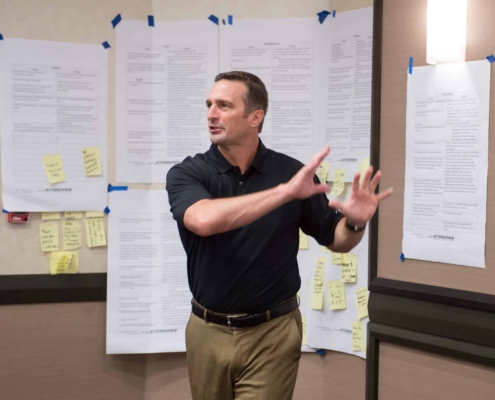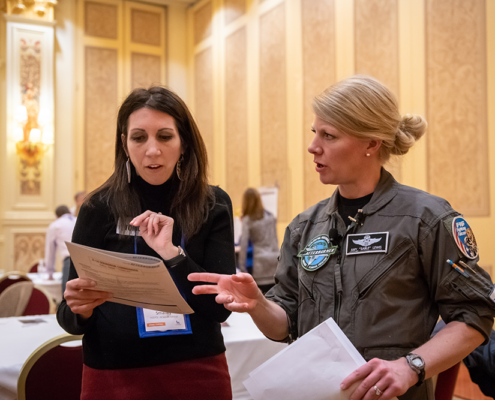 https://www.afterburner.com/wp-content/uploads/2024/09/leadership-symposium-afterburner.png
1050
1832
Nate Riggins
/wp-content/uploads/2024/07/Afterburner-Logo-Resize-Fullcolor-300x93.png
Nate Riggins2024-01-26 15:53:082024-12-21 14:56:28Decoding the 3 Crucial Leadership Situations
https://www.afterburner.com/wp-content/uploads/2024/09/leadership-symposium-afterburner.png
1050
1832
Nate Riggins
/wp-content/uploads/2024/07/Afterburner-Logo-Resize-Fullcolor-300x93.png
Nate Riggins2024-01-26 15:53:082024-12-21 14:56:28Decoding the 3 Crucial Leadership Situations
Everyone reacts to task saturation differently, and unhealthy coping mechanisms will only prolong the saturation. The only way to get back on your feet and increase productivity is to eliminate task saturation.
First and foremost, you need to train your employees to recognize task saturation when it starts to hit them. More often than not, properly trained employees will be able to sense task saturation occurring, and then adjust as they see themselves reverting to an inappropriate coping mechanism.
Just because your employees can see the signs and triggers of task saturation doesn’t mean that you’re out of the clear yet, you need to take task saturation out of your workplace. Kill the weeds before they choke the grass. That doesn’t mean you should lighten the workload, but rather, build into your company standards three simple processes that fighter pilots use to keep task saturation at bay.
3 Simple Ways to Eliminate Task Saturation
Checklists
The first tool fighter pilots have to eliminate task saturation is their checklist. It may seem trivial, but it’s a memory device. It’s based on training, people’s experience, and the standard operating procedures of your company. They help guide employees around “choke points,” places where there can be delays or situations that can bring operating systems to a halt. Find what areas of your business could cause choke points and build in a stress-reducing checklist that the everyday employee can revert to.
Cross-Checks
The pilot’s second tool is a cross-check. Imagine, if you will, what it’s like for a single-seat fighter pilot to monitor 350 switches and dials, all at once. How do they stay focused on the overall mission objective and still fly the aircraft? That’s where cross-checks come into play. Of the 350 instruments in the cockpit, there are a few that are crucial to pay attention to.
- Attitude Indicator: A little ball suspended in fluid half brown, half blue, representing the ground and the sky. If the pilot sees more brown than blue, the aircraft is in dive. If he or she sees more blue than brown, the aircraft is in a climb.
- Altimeter: A key instrument that indicates how high an aircraft is flying. It helps pilots see if they are on track and if everything is operating smoothly. If it indicates that something is wrong, they head back to the attitude indicator and adjust, then back to the altimeter, and so on.
This is the hub and spoke of the cockpit cross-check. Back and forth to key instruments, always scanning, never channelizing. So how does this translate to your business? For most companies, your attitude indicator is customer satisfaction. Are they happy? Do they rate your service highly? You read this every day, every hour.
The priorities of your business determine your other instruments. Maybe it’s the sales funnel or click-through on a website. Whatever it may be, your defined instrument panel needs to help you get regular data inputs that you can run across a smooth, disciplined cross-check.
Mutual Support
The last tool is called mutual support. Pilots never go anywhere without a wingman. They fly as a team, and their wingman is their partner, who is positioned strategically to assist the pilot if he or she gets into trouble. In your business, do you know enough about the roles of others on your local or remote teams?
Mutual support requires that we learn each other’s roles and rely on each other. The more you know about the other’s job, the easier it will be for you to eliminate task saturation. Words are the swords in the combat of businesses, and two people operating together allow for latitude in negotiations and operations.
Take the time to talk to your team about task saturation. You’d be surprised how much change you can engineer with simple education. If you’re not sure where or how to start, let our team building consultants give you a hand.
Our consultants are experts at building cohesive teams and eliminating task saturation in your business. Reach out to us here to get started.
Share This Post
More Like This
 https://www.afterburner.com/wp-content/uploads/2024/09/leadership-symposium-afterburner.png
1050
1832
Nate Riggins
/wp-content/uploads/2024/07/Afterburner-Logo-Resize-Fullcolor-300x93.png
Nate Riggins2024-01-26 15:53:082024-12-21 14:56:28Decoding the 3 Crucial Leadership Situations
https://www.afterburner.com/wp-content/uploads/2024/09/leadership-symposium-afterburner.png
1050
1832
Nate Riggins
/wp-content/uploads/2024/07/Afterburner-Logo-Resize-Fullcolor-300x93.png
Nate Riggins2024-01-26 15:53:082024-12-21 14:56:28Decoding the 3 Crucial Leadership Situations https://www.afterburner.com/wp-content/uploads/2024/09/thethreebiggest-1.jpeg
931
1400
Nate Riggins
/wp-content/uploads/2024/07/Afterburner-Logo-Resize-Fullcolor-300x93.png
Nate Riggins2024-01-03 15:04:522024-12-21 14:56:29The Three Biggest Obstacles to Building Trust as a Leader Today
https://www.afterburner.com/wp-content/uploads/2024/09/thethreebiggest-1.jpeg
931
1400
Nate Riggins
/wp-content/uploads/2024/07/Afterburner-Logo-Resize-Fullcolor-300x93.png
Nate Riggins2024-01-03 15:04:522024-12-21 14:56:29The Three Biggest Obstacles to Building Trust as a Leader Today https://www.afterburner.com/wp-content/uploads/2024/09/creating-a-strategy-1.jpeg
664
1000
Nate Riggins
/wp-content/uploads/2024/07/Afterburner-Logo-Resize-Fullcolor-300x93.png
Nate Riggins2024-01-03 08:00:192024-12-21 14:56:294 Questions You Have to Ask When Creating a Strategy
https://www.afterburner.com/wp-content/uploads/2024/09/creating-a-strategy-1.jpeg
664
1000
Nate Riggins
/wp-content/uploads/2024/07/Afterburner-Logo-Resize-Fullcolor-300x93.png
Nate Riggins2024-01-03 08:00:192024-12-21 14:56:294 Questions You Have to Ask When Creating a Strategy https://www.afterburner.com/wp-content/uploads/2024/09/CVMV_0008.jpg
1547
2100
Nate Riggins
/wp-content/uploads/2024/07/Afterburner-Logo-Resize-Fullcolor-300x93.png
Nate Riggins2022-11-10 15:37:382024-12-21 14:56:355 Leadership Skills to Get Your Revenue Engine Roaring in Q4
https://www.afterburner.com/wp-content/uploads/2024/09/CVMV_0008.jpg
1547
2100
Nate Riggins
/wp-content/uploads/2024/07/Afterburner-Logo-Resize-Fullcolor-300x93.png
Nate Riggins2022-11-10 15:37:382024-12-21 14:56:355 Leadership Skills to Get Your Revenue Engine Roaring in Q4
A Word from Murph: Right Now, Leadership in Business Means Going Back to Basics
Inspiration, Leadership, Leadership Development https://www.afterburner.com/wp-content/uploads/2024/09/AdobeStock_198086711-1.jpeg
1265
2048
Nate Riggins
/wp-content/uploads/2024/07/Afterburner-Logo-Resize-Fullcolor-300x93.png
Nate Riggins2020-03-30 09:00:352024-12-21 14:56:397 Leadership Tips to Motivate Your Remote Employees
https://www.afterburner.com/wp-content/uploads/2024/09/AdobeStock_198086711-1.jpeg
1265
2048
Nate Riggins
/wp-content/uploads/2024/07/Afterburner-Logo-Resize-Fullcolor-300x93.png
Nate Riggins2020-03-30 09:00:352024-12-21 14:56:397 Leadership Tips to Motivate Your Remote Employees https://www.afterburner.com/wp-content/uploads/2024/09/woman-showing-how-to-improve-your-situational-awareness-with-map-in-background-1.png
667
1000
Nate Riggins
/wp-content/uploads/2024/07/Afterburner-Logo-Resize-Fullcolor-300x93.png
Nate Riggins2020-03-22 07:00:122024-12-21 14:56:403 Ways to Improve Your Situational Awareness
https://www.afterburner.com/wp-content/uploads/2024/09/woman-showing-how-to-improve-your-situational-awareness-with-map-in-background-1.png
667
1000
Nate Riggins
/wp-content/uploads/2024/07/Afterburner-Logo-Resize-Fullcolor-300x93.png
Nate Riggins2020-03-22 07:00:122024-12-21 14:56:403 Ways to Improve Your Situational Awareness https://www.afterburner.com/wp-content/uploads/2024/09/team-sitting-in-a-meeting-listening-to-how-to-cope-with-task-saturation-1.png
439
1000
Nate Riggins
/wp-content/uploads/2024/07/Afterburner-Logo-Resize-Fullcolor-300x93.png
Nate Riggins2020-02-14 09:00:522024-12-21 14:56:40Identifying your Task Saturation Coping Mechanisms
https://www.afterburner.com/wp-content/uploads/2024/09/team-sitting-in-a-meeting-listening-to-how-to-cope-with-task-saturation-1.png
439
1000
Nate Riggins
/wp-content/uploads/2024/07/Afterburner-Logo-Resize-Fullcolor-300x93.png
Nate Riggins2020-02-14 09:00:522024-12-21 14:56:40Identifying your Task Saturation Coping Mechanisms https://www.afterburner.com/wp-content/uploads/2024/09/two-women-looking-at-paper-forcing-communication-in-business-1.png
667
1000
Nate Riggins
/wp-content/uploads/2024/07/Afterburner-Logo-Resize-Fullcolor-300x93.png
Nate Riggins2019-06-19 09:00:192024-12-21 14:56:41Why is Tone so Important When it Comes to Communication in Business?
https://www.afterburner.com/wp-content/uploads/2024/09/two-women-looking-at-paper-forcing-communication-in-business-1.png
667
1000
Nate Riggins
/wp-content/uploads/2024/07/Afterburner-Logo-Resize-Fullcolor-300x93.png
Nate Riggins2019-06-19 09:00:192024-12-21 14:56:41Why is Tone so Important When it Comes to Communication in Business?About Us
Building Strong Teams Through the Guidance of Fighter Pilot Keynote Speakers.

